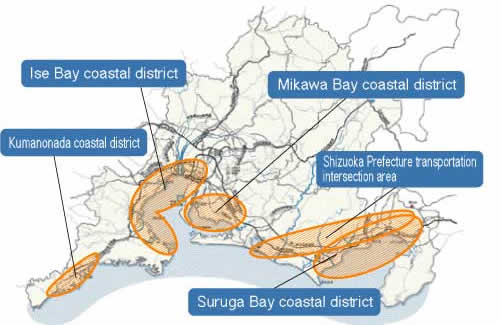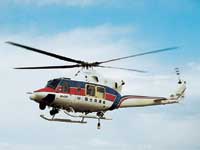 |
The Central Japan Region has learned from past disasters typified by the Tokai Deluge of September 2000 and is now creating a disaster prevention system that can provide appropriate protection from the Tokai Earthquake, Tonankai Earthquake and others that are expected to strike the region in the near future.
In response to the Tokai Earthquake Countermeasure Principles that the Central Disaster Prevention Council prepared as a master plan for Tokai Earthquake measures in May 2003, the Chubu Regional Bureau has, in October 2003, selected districts where priority implementation of earthquake measures should be carried out under “Priority Countermeasures of the Chubu Regional Bureau” to prioritize countermeasures in preparation for the Tokai Earthquake and other large earthquakes.

One lesson learned from past disasters is that it is important for all organizations
to strengthen their links in order to perform their assistance and restoration
activities efficiently. Because the Central Japan Region is a region in danger
of the occurrence over a wide area of disasters such as the Tokai Earthquake,
Tonankai Earthquake, or an eruption of Mt. Fuji, efforts must be made to prepare
for such disasters.
It is, therefore, extremely important to comprehensively
collect and analyze information about damage caused by disasters and its restoration
and apply it to perform prompt restoration and assistance activities.
The
Chubu Regional Bureau shares information about disasters in the 5 prefectures
and 2 cities in its jurisdiction (the prefectures of Nagano, Gifu, Aichi, Shizuoka,
and Mie and the cities of Nagoya and Shizuoka) and at the same time, it provides
an environment that encourages all the residents of the region to collect information
and provides them with the information that it has shared.


In
March 2002, Mannaka that is a helicopter used for disaster prevention was obtained
to respond appropriately to a wide-area disaster by promptly collecting information.
In addition to its ability to perform wide area prompt information collection
and to support disaster prevention measures during a disaster, it can also be
used to inspect facilities at normal times.
| Mutual cooperation between prefectures and cities (prior agreements) | Prefectures within the jurisdiction and the City of Nagoya make agreements to exchange information and to allow disaster prevention bodies in the Chubu Regional Bureau to loan disaster countermeasure machinery in order to prevent the expansion of the disaster and to rapidly restore damaged facilities. |
| Agreement to exchange
information with the Land Self Defense Forces | Tenth Division in Gifu,
Aichi, and Mie First Division in Shizuoka Twelfth Division in Nagano (Nanshin) |
| Cooperation with private sector organizations | Agreements to support emergency response countermeasures are made with eight groups of private sector companies in order to provide emergency assistance and restoration during disasters caused by earthquake or by wind and rain. |
| Disaster prevention expert system | System of voluntary support for and cooperation with the collection of disaster information. Registered experts: 542 (as of October 2003) |